| Pages:
1
2
3
..
10 |
Brain&Force
Hazard to Lanthanides
    
Posts: 1302
Registered: 13-11-2013
Location: UW-Madison
Member Is Offline
Mood: Incommensurately modulated
|
|
Rador Labs Challenge 11-12/2014: High Stakes, High Mass
Rador Labs is announcing the first of its monthly challenges. We've drafted up some rules for the competition, which are described in detail here. Please read the rules thoroughly before you submit an entry.
The challenge is to make the heaviest compound by molar mass. Pure starting materials must have a molar mass less than 260 g/mol and starting
materials extracted from impure sources must have a molar mass less than 500 g/mol.
Another way to enter is to just extract the heaviest compound possible. However, you cannot react the extracted compound with anything.
Polymers, proteins, and DNA don't count.
The competition starts at 15 November 2014. The winner will be announced within a day of the end of the challenge, on 15 December 2014 at 00:00 UTC.
Updates will be posted biweekly regarding any extensions or reductions of the challenge time.
Happy reacting!
[Edited on 14.11.2014 by Brain&Force]
At the end of the day, simulating atoms doesn't beat working with the real things...
|
|
|
NexusDNA
Hazard to Others
  
Posts: 104
Registered: 23-11-2013
Location: Brazil, under an umbrella
Member Is Offline
Mood: Liberated from cocoon
|
|
Great initiative! Just to get an idea... how much is heavy? 2500, 5000 g/mol?
Bromine, definitely bromine.
|
|
|
Brain&Force
Hazard to Lanthanides
    
Posts: 1302
Registered: 13-11-2013
Location: UW-Madison
Member Is Offline
Mood: Incommensurately modulated
|
|
Heaviest is defined as heavier than the next heaviest compound.
If you isolate deuterium and the only other entry was just regular hydrogen, you win. 
[Edited on 15.11.2014 by Brain&Force]
At the end of the day, simulating atoms doesn't beat working with the real things...
|
|
|
Texium
Administrator
       
Posts: 4580
Registered: 11-1-2014
Location: Salt Lake City
Member Is Offline
Mood: PhD candidate!
|
|
Alright, here's a little something to get this started...
Copper(II) acetylsalicylate (or copper aspirinate) weighing in at 843.69 g/mol.
The reason that it is so heavy is that copper forms dinuclear complexes with carboxylic acids, so this compound is twice as heavy as one would first
expect.
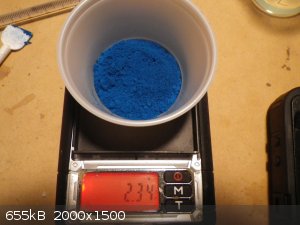
For the preparation, I followed bfesser's first procedure.
Materials:
3.14g Acetylsalicylic acid (recrystallized from aspirin tablets using OTC EtOH, Everclear, as the solvent)
1.30g Sodium bicarbonate (baking soda)
2.01 Copper(II) sulfate pentahydrate (recrystallized from root killer)
Explanation:
The procedure that I used first calls for the preparation of sodium acetylsalicylate from acetylsalicylic acid and sodium bicarbonate via an acid-base
reaction, and then using that to precipitate the insoluble copper salt via reaction with copper(II) sulfate.
HC9H7O4 + NaHCO3 --> NaC9H7O4 + CO2 + H2O
4NaC9H7O4 + 2CuSO4 -->
Cu2(C9H7O4)4 + 2Na2SO4
I started by calculating the masses of each compound I'd need for the procedure. I was originally going to prepare it on a 40 mmol scale, but I didn't
have enough ASA, so I reduced the amounts for the max amount of ASA that I had (3.14g). I dissolved the bicarbonate in some water, added the ASA to a
250mL Erlenmeyer flask and then slowly added the bicarbonate solution to the flask. At this point, I also prepared the copper sulfate solution
separately. I let the mixture sit for a while until gas was no longer being evolved and most of the ASA had dissolved. After that, I slowly combined
the two solutions. At first, I was concerned that nothing was happening, as there was no apparent precipitation, and the solution had turned from blue
to green. I took a plastic stir stick and began agitating the solution. At this point, the striking blue precipitate began to form. After waiting a
few minutes for the reaction to be completed, I vacuum filtered the precipitate, pulled air through for a few minutes to dry it, and then weighed it.
My final yield of copper(II) acetylsalicylate was 2.34 grams, which is a pretty sad yield, but enough to qualify for this competition, and to make a
nice addition to my compound collection, and the 8th copper compound that I have in it. I don't expect to win this competition with this compound, but
I wanted to submit something fairly simple to start with.
Left to right, top to bottom: The starting reagents, the precipitation reaction, vacuum filtration of the product, the precipitate in the frit funnel.
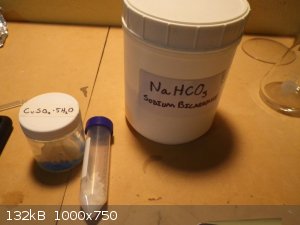 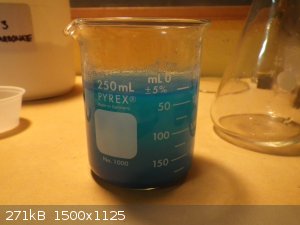
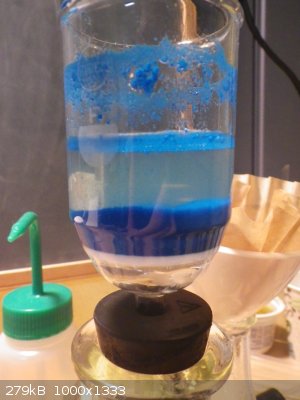 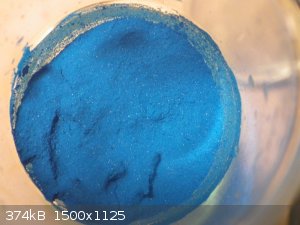
Oh, and I will make a donation for this entry, although I have not yet.
|
|
|
j_sum1
Administrator
       
Posts: 6320
Registered: 4-10-2014
Location: At home
Member Is Offline
Mood: Most of the ducks are in a row
|
|
Question. Does water of crystallisation count?
|
|
|
blogfast25
International Hazard
    
Posts: 10562
Registered: 3-2-2008
Location: Neverland
Member Is Offline
Mood: No Mood
|
|
Yes. See linked to rules in opening post.
Quote: Originally posted by zts16  | Alright, here's a little something to get this started...
Copper(II) acetylsalicylate (or copper aspirinate) weighing in at 843.69 g/mol.
|
Pff... a truly lovely synth is that but off the top of my head I can think of at least one compound that is much simpler to prepare and beats 844
pants down. Totally OTC, of course.
And another one, more than 3 times heavier than copper aspirinate...
[Edited on 15-11-2014 by blogfast25]
|
|
|
Amos
International Hazard
    
Posts: 1406
Registered: 25-3-2014
Location: Yes
Member Is Offline
Mood: No
|
|
Quote: Originally posted by blogfast25  |
Pff... a truly lovely synth is that but off the top of my head I can think of at least one compound that is much simpler to prepare and beats 844
pants down. Totally OTC, of course.
And another one, more than 3 times heavier than copper aspirinate...
[Edited on 15-11-2014 by blogfast25] |
Hey, you've gotta start somewhere. And if you were already going to make the compound anyway, you may as well submit it.
|
|
|
blogfast25
International Hazard
    
Posts: 10562
Registered: 3-2-2008
Location: Neverland
Member Is Offline
Mood: No Mood
|
|
Perhaps not with something that is so obviously lighter than compounds that took about 3 minutes to spring to my feeble mind? Do you think the people
that will take part in that composition were born yesterday? 
|
|
|
Texium
Administrator
       
Posts: 4580
Registered: 11-1-2014
Location: Salt Lake City
Member Is Offline
Mood: PhD candidate!
|
|
Quote: Originally posted by blogfast25  |
Perhaps not with something that is so obviously lighter than compounds that took about 3 minutes to spring to my feeble mind? Do you think the people
that will take part in that composition were born yesterday? 
|
Well, I guess my mind is far more feeble than yours then...
I was trying to think of some other simple things off the top of my head that would beat it and I wasn't able to find anything. Keep in mind I've been
doing this for less than a year, so I don't have an entire chemical catalog in my head yet, and each time I thought that something seemed like it
would be higher than 843, it wasn't. I just wanted to reserve a place, and now I'm going to continue looking for something heavier. I think I made
that pretty clear in my post.
Edit: I have an entire week off of school for Thanksgiving, the week after next, and we'll see what I can do during that time.
[Edited on 11-15-2014 by zts16]
|
|
|
Amos
International Hazard
    
Posts: 1406
Registered: 25-3-2014
Location: Yes
Member Is Offline
Mood: No
|
|
Quote: Originally posted by blogfast25  |
Perhaps not with something that is so obviously lighter than compounds that took about 3 minutes to spring to my feeble mind? Do you think the people
that will take part in that composition were born yesterday? 
|
Hurry up and submit something then, so we can stop talking about zts16's clearly shameful attempts at home chemistry!
|
|
|
Praxichys
International Hazard
    
Posts: 1063
Registered: 31-7-2013
Location: Detroit, Michigan, USA
Member Is Offline
Mood: Coprecipitated
|
|
Compound Name: Silver (I) Tetraiodomercurate (II)
Molecular Mass: 923.94
Donated
1.43g Ag2HgI4 in a vial:
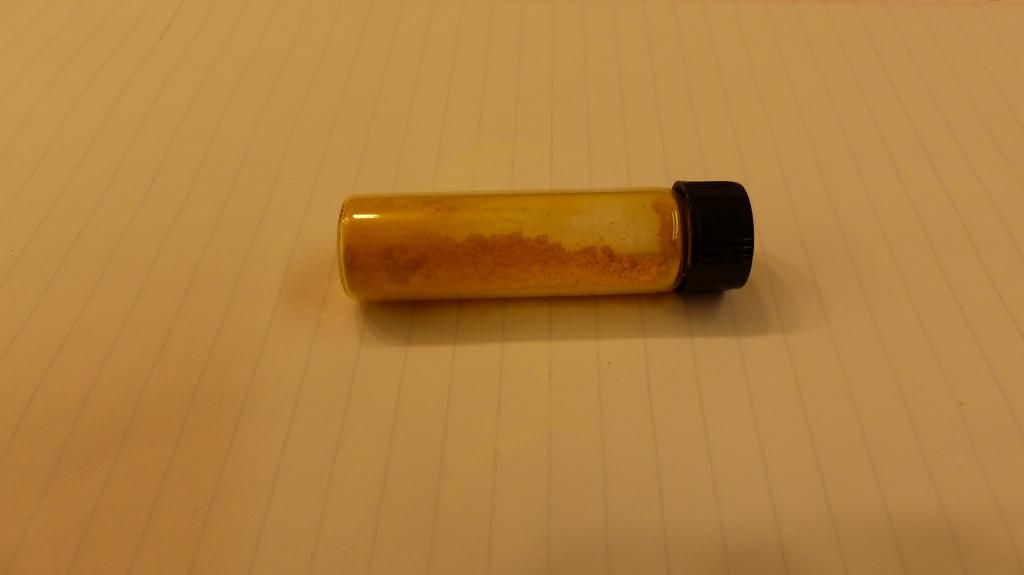
2AgNO3 + Hg(NO3)2 + 4KI --> Ag2HgI4 + 4 KNO3
First, 0.43g silver metal and 0.40g Hg was measured out. They were then combined. Mercury instantly wets silver and forms a nice amalgam.
 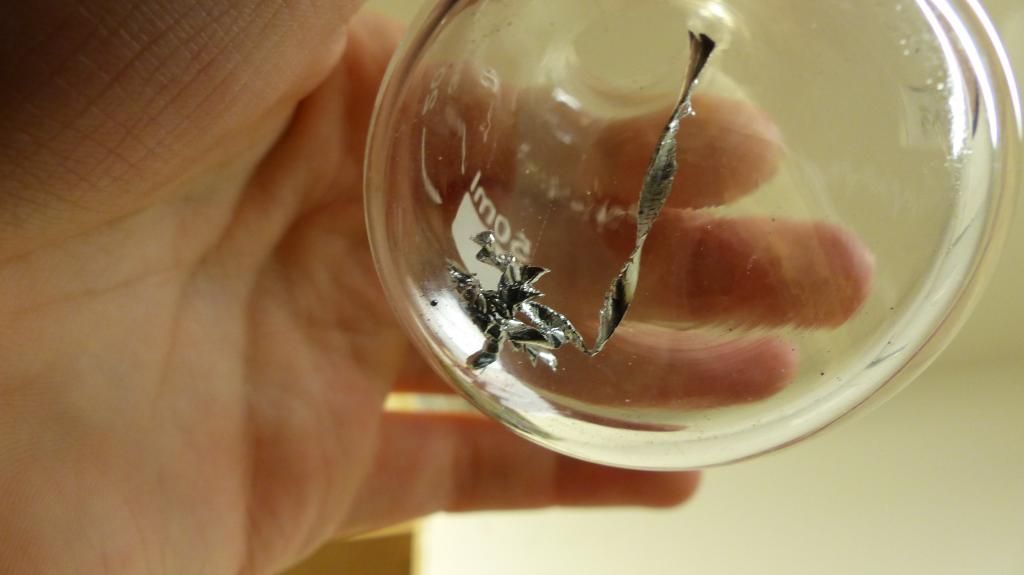
An excess of 68% nitric acid was added to the silver/mercury to dissolve both, evolving nitrogen oxides and some heat. The amalgam is very reactive
toward nitric acid. Separately, 1.4g KI was weighed out and dissolved in a minimum of water. Very little water is required as KI is very soluble.
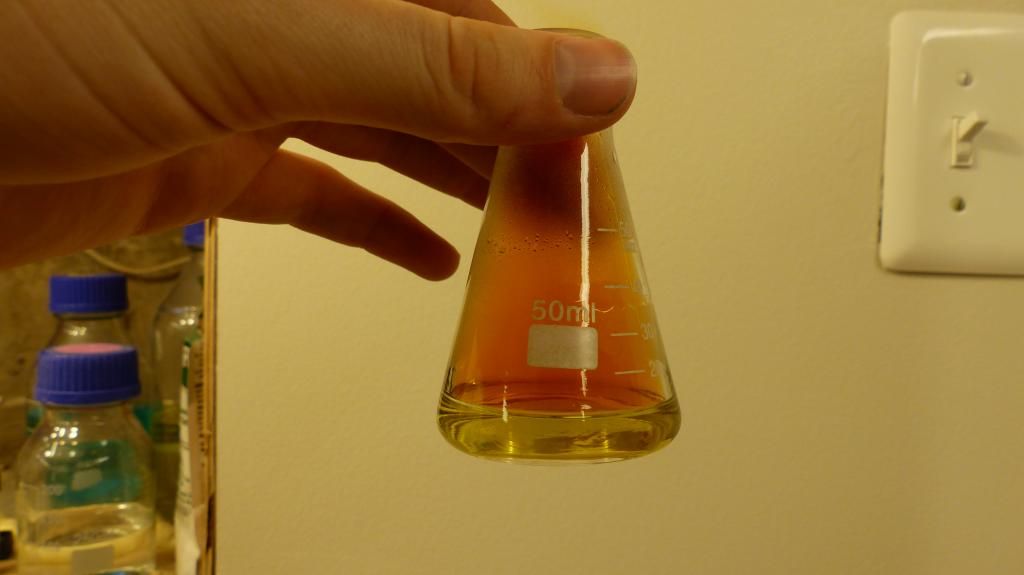 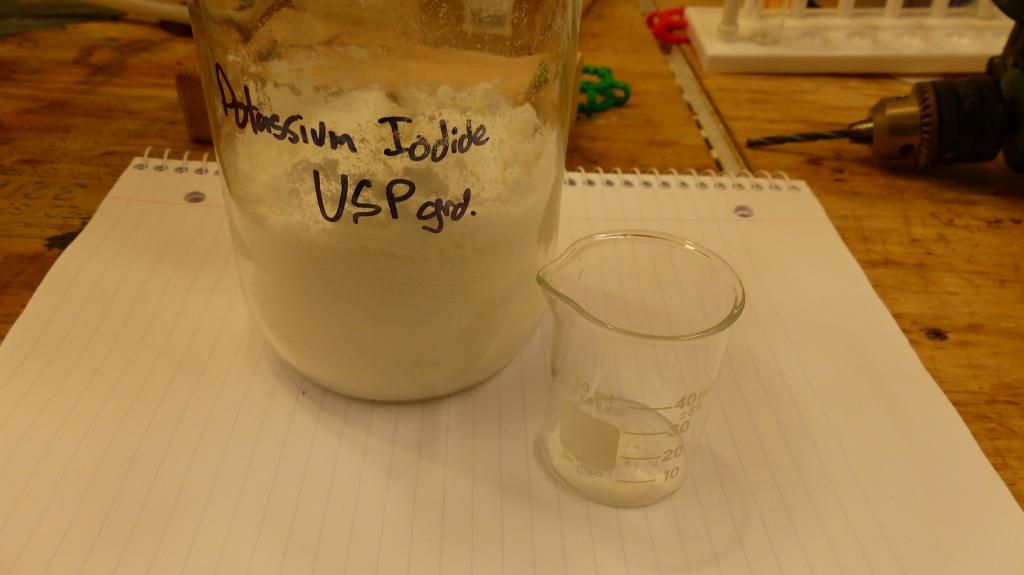
The two solutions were rapidly combined, changing a multitude of colors as species of I2, AgI and HgI2 equilibrated. The end
result was a heavy, flocculant yellow powder. This was vacuum filtered on two coffee filters sitting on a medium frit in a 60ml Büchner funnel.
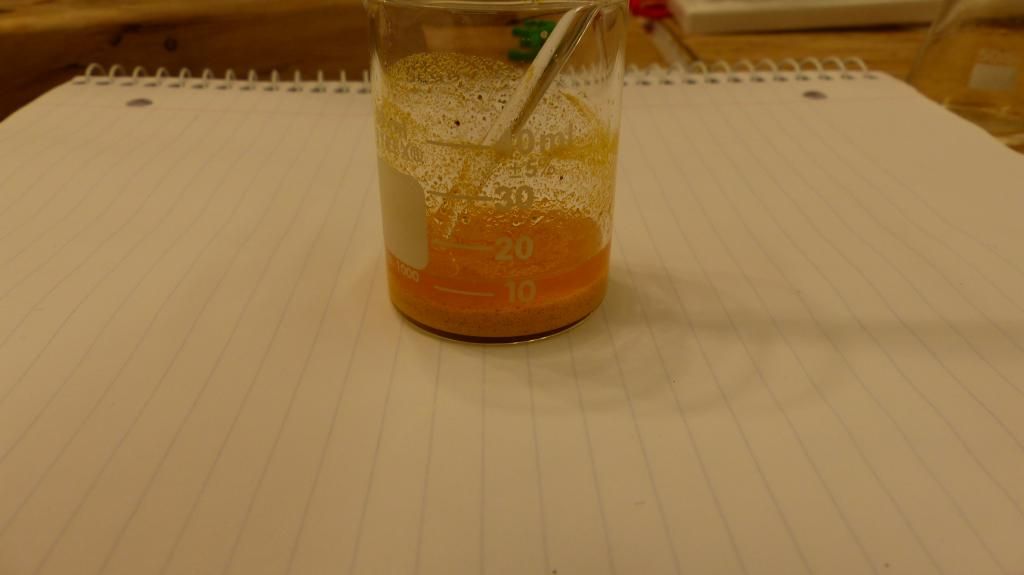 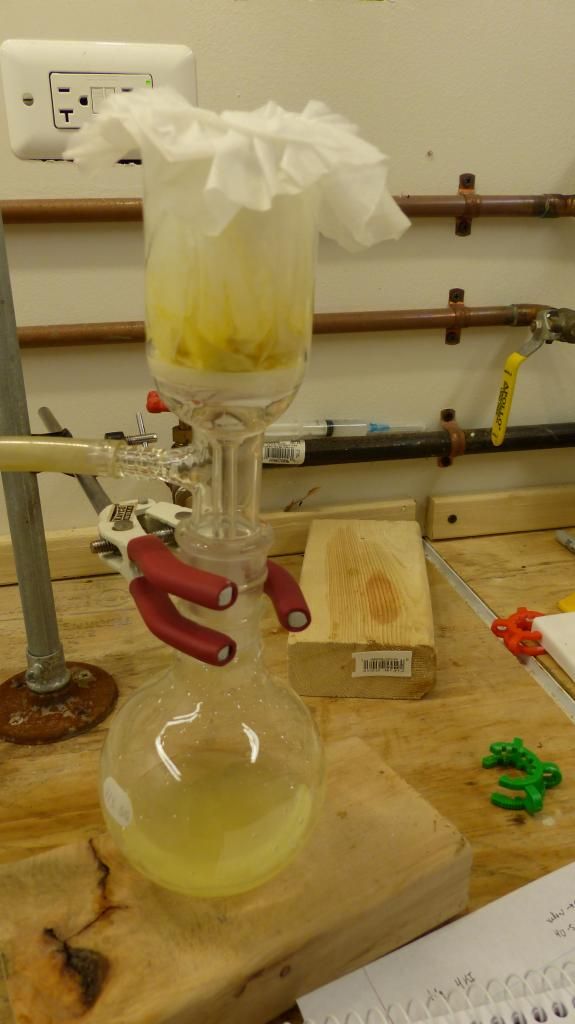
After drying, a fine, heavy yellow powder is obtained, as seen in the first photo. The powder is strikingly thermochromic at about 50°C. In the
following images, the room temperature filter paper is shown next to the same paper heated by a hot-air gun. The color change is completely
reversible, and the effect is especially gratifying on the filter paper since it changes temperature rapidly, as opposed to the bulk powder in the
vial which takes a few minutes to cool down.
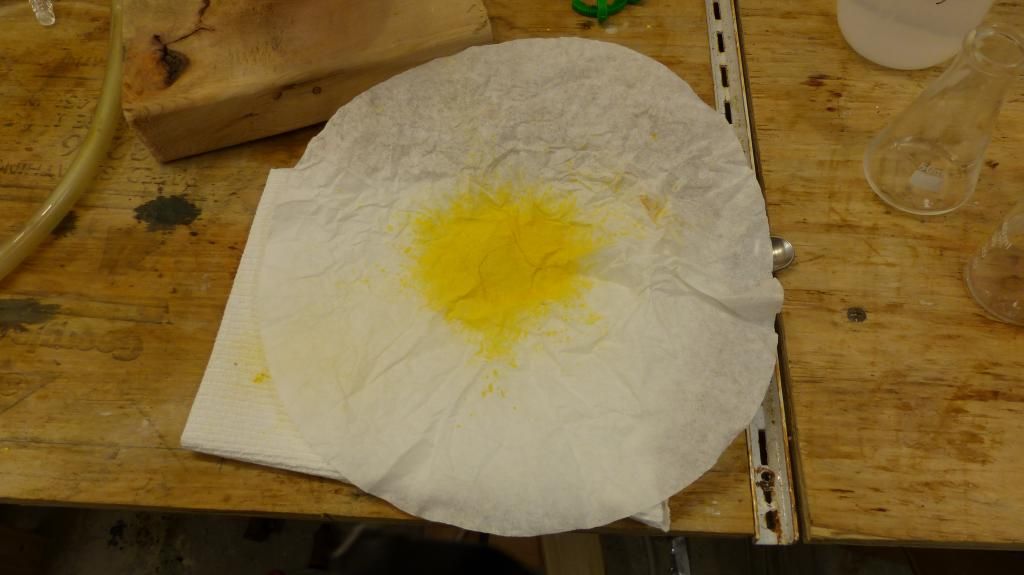 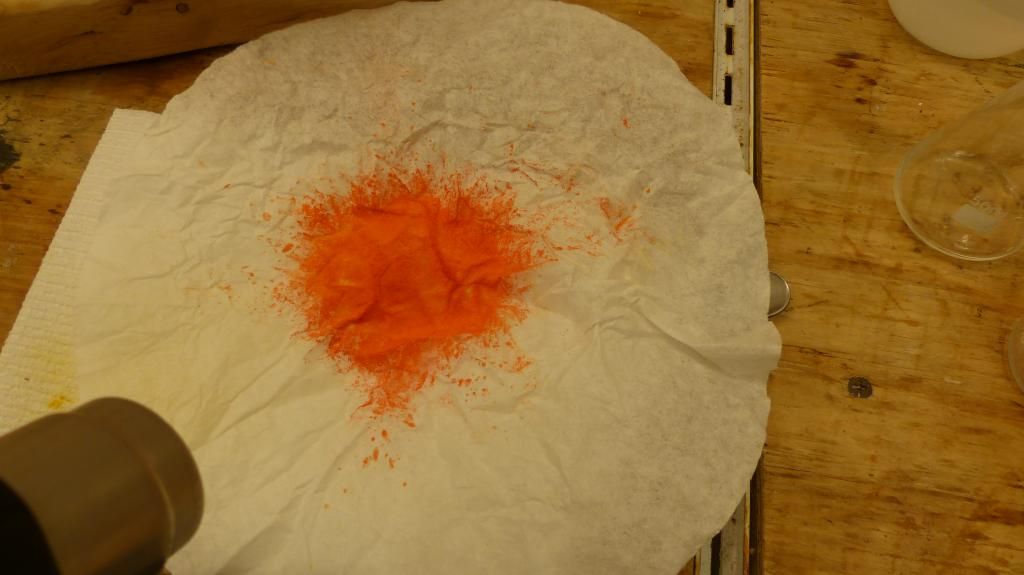
Some experimental notes:
Drying with acetone does not work. I believe the compound reacts to form iodoacetone. No further investigation was made.
The copper version of this compound is used to test for mercury. CuI on paper is swabbed on surfaces, forming the corresponding copper
tetraiodomercurate, which is a different color than the iodide. Copper and silver react similarly, so silver iodide could also be used in this manner.
However, silver iodide is photosensitive and prone to decomposition in storage, not to mention expensive.
[Edited on 15-11-2014 by Praxichys]
|
|
|
blogfast25
International Hazard
    
Posts: 10562
Registered: 3-2-2008
Location: Neverland
Member Is Offline
Mood: No Mood
|
|
Nice work. The thermochromism points to an endothermic and reversible (equilibrium) transition, but which one?
|
|
|
aga
Forum Drunkard
    
Posts: 7030
Registered: 25-3-2014
Member Is Offline
|
|
Superb work Praxichys.
Rule test: if i come and steal your sample, then make sure you can't get it back, does that count as Isolating the Compound
(from you in this case) ?
|
|
|
Amos
International Hazard
    
Posts: 1406
Registered: 25-3-2014
Location: Yes
Member Is Offline
Mood: No
|
|
Quote: Originally posted by aga  | Superb work Praxichys.
Rule test: if i come and steal your sample, then make sure you can't get it back, does that count as Isolating the Compound
(from you in this case) ? |
 Even if you did, you'd be tied with him. And since he's chronologically
first... Even if you did, you'd be tied with him. And since he's chronologically
first...
|
|
|
Tsjerk
International Hazard
    
Posts: 3032
Registered: 20-4-2005
Location: Netherlands
Member Is Offline
Mood: Mood
|
|
What is the definition of a polymer (as in the rules)?
|
|
|
The Volatile Chemist
International Hazard
    
Posts: 1981
Registered: 22-3-2014
Location: 'Stil' in the lab...
Member Is Offline
Mood: Copious
|
|
Darn.... I spent a lot of my day making something for the competition, Barium bistartratocuprate(II), and the final product would have only been
632.27 g/mol :/ Hard to beat that most recent one. Do we even consider mercury, iodine, and silver OTC? They hardly are.
Regarding my experimentation today, I at least got some Fehling's solution and calcium bistartratocuprate(II) out of it. Turns out the latter still is
an ok indicator for sugar type (Like Fehling's solution, a potassium/sodium double salt). Although it's not exactly for the competition; as it can't
beat the two posted above, and I can't donate anyways (Like what are you even using donations for?); I still am posting pictures of the procedure,
kind of pretty. I proved the bistartratocuprate(II) complex formed, with glycerin. The below link proves glycerin gives a positive Fehling test:
http://books.google.com/books?id=f5EtAQAAMAAJ&pg=PA302&a...
Sorry about image size.
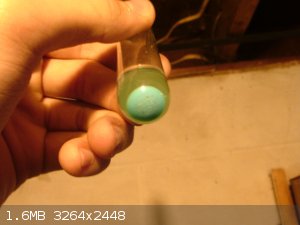 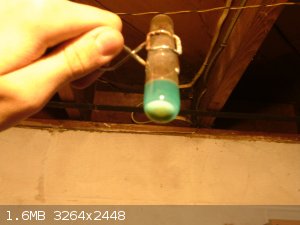 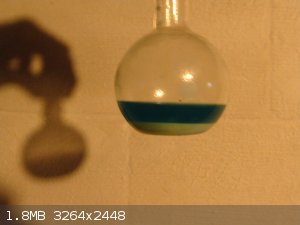 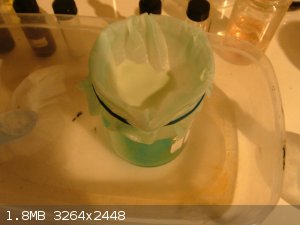
The first one is the test run precipitate, the second is the cuprous oxide precipitate, the third is the real run, and the fourth is the filtered off
calcium bistartratocuprate(II).
[Edited on 11-15-2014 by The Volatile Chemist]
|
|
|
Texium
Administrator
       
Posts: 4580
Registered: 11-1-2014
Location: Salt Lake City
Member Is Offline
Mood: PhD candidate!
|
|
The donations go to the winner (if they donated). It's the prize money essentially.
Also, it looks looks like an interesting compound that you made. I'll have to check it out. 
And in the Skype group, Praxichys explained in detail how each of the reagents he used can be OTC, so his submission does count.
[Edited on 11-15-2014 by zts16]
|
|
|
Brain&Force
Hazard to Lanthanides
    
Posts: 1302
Registered: 13-11-2013
Location: UW-Madison
Member Is Offline
Mood: Incommensurately modulated
|
|
A polymer is anything that's a long, indefinitely repeating unit. You must be able to give a structure and formula. Proteins and DNA are not allowed
unless they are synthesized, not extracted.
NexusDNA asked if disaccharides are OK. They are.
At the end of the day, simulating atoms doesn't beat working with the real things...
|
|
|
blogfast25
International Hazard
    
Posts: 10562
Registered: 3-2-2008
Location: Neverland
Member Is Offline
Mood: No Mood
|
|
Quote: Originally posted by The Volatile Chemist  | | Darn.... I spent a lot of my day making something for the competition, Barium bistartratocuprate(II), and the final product would have only been
632.27 g/mol :/ Hard to beat that most recent one. |
No, no: easy peasy, actually! 
Still, very nice compound indeed.
|
|
|
Tsjerk
International Hazard
    
Posts: 3032
Registered: 20-4-2005
Location: Netherlands
Member Is Offline
Mood: Mood
|
|
What is the definition of a polymer (as in the rules)?
|
|
|
Amos
International Hazard
    
Posts: 1406
Registered: 25-3-2014
Location: Yes
Member Is Offline
Mood: No
|
|
Read about 3 posts up...
|
|
|
HeYBrO
Hazard to Others
  
Posts: 289
Registered: 6-12-2013
Location: 'straya
Member Is Offline
Mood: 
|
|
Quote: Originally posted by zts16  | Alright, here's a little something to get this started...
Copper(II) acetylsalicylate (or copper aspirinate) weighing in at 843.69 g/mol. |
Damn it! that was the first thing that came to mind! and i have all the photos of the synth too! 
Good job everyone who entered so far!
|
|
|
Tsjerk
International Hazard
    
Posts: 3032
Registered: 20-4-2005
Location: Netherlands
Member Is Offline
Mood: Mood
|
|
What is the definition of a polymer (as in the rules)?
|
|
|
aga
Forum Drunkard
    
Posts: 7030
Registered: 25-3-2014
Member Is Offline
|
|
more than one monomer conjoined ?
|
|
|
Praxichys
International Hazard
    
Posts: 1063
Registered: 31-7-2013
Location: Detroit, Michigan, USA
Member Is Offline
Mood: Coprecipitated
|
|
Post them anyway! I am interested to see how you did it.
|
|
|
| Pages:
1
2
3
..
10 |